Notes: The station was renamed South West India Dock in July 1881 but reverted to its original name of South Dock in May 1895.
 |
The isolated station stood in the middle of the dock estate surrounded by timber yards and some distance from the nearest road, it was sited on the east side of the line, north-east of the South Dock. The station buildings were of timber with a slate roof standing on a brick faced platform. It was staffed entirely by dock employees and issued its own company tickets. South |
Dock Station had the only passing loop on the line. The Millwall Extension Railway's managing committee, appointed by the joint owners, had its offices at this station, which was destroyed by fire in 1917.
BRIEF HISTORY OF THE MILLWALL EXTENSION RAILWAY
In 1863, the London and Blackwall Railway Company proposed a line across the Isle of Dogs from a junction at Limehouse. The proposed route would cross the western entrances to the West India Docks running south to serve new industries at Millwall, terminating on the north bank of the Thames at Cubitt Town from where there was a ferry to Greenwich.
The proposed line was vigorously opposed by the East and West India Dock Company and rejected by Parliament in 1864 because of the adverse effect it would have on the docks.
| The Great Eastern Railway took a long lease on the London & Blackwall line in 1864 and revived the scheme for a branch line across the Isle of Dogs following the successful Bill for the construction of the Millwall Docks. The East and West India Dock Company were still reluctant to allow the railway to pass through their estate and suggested an alternative |
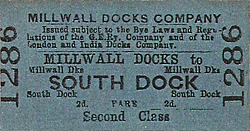 |
route across the east side of the West India Docks, where there was already a siding.
A further Bill was submitted to Parliament and the railway companies were forced to amend their proposals to accommodate the dock company, agreeing to build either a tunnel under the docks or a line on their east side, which the dock company would build and control with the right to exclude passengers and locomotives, to reduce fire risks.
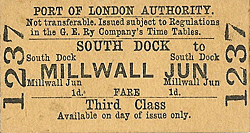 |
The Millwall Extension Railway Bill was passed on 19 June 1865 but apart from the junction with the Blackwall line at Poplar, nothing was done as a number of factories that the line was intending to serve went out of business following the financial crash of 1866. The GER lost interest in the line and the raising of capital was left to the London and Blackwall |
company, The Millwall Freehold Land and the Docks Company. The rebuilding of the South Dock of the West India Docks from 1867 rendered the tunnel option impracticable.
Finance was finally secured in May 1868 and it was agreed that the London & Blackwall would build the first 5 chains of the line from the junction at Poplar to the West India Dock estate boundary. The dock companies would build and finance the sections of line on their own property, 41 chains through land owned by the East & West India Dock Company and 52 chains along the eastern edge of the Millwall Dock estate. The final 31 chains was built by the London & Blackwall making a total length of 1 mile 49 chains.
| The branch was laid with light rails opening on 18th December 1871 between a new junction station on the London & Blackwall line called Millwall Junction and Millwall Docks station with an intermediate station at South Dock within the East & West India Docks. This section of the line opened for freight and a workmen's service was also provided. Work on the remainder of |
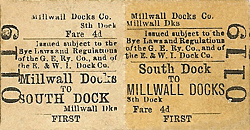 |
the single track line started early the following year opening to North Greenwich with a full passenger service on the 29th July 1872. The terminus was actually in the new working class residential district of Cubitt Town but the GER chose the more 'up market' North Greenwich for the terminus which was sited 200 yards from the jetty served by the Greenwich ferry. The main civil engineering features of the line were three swing bridges and a brick arched viaduct between Millwall Dock station and North Greenwich.
Initially steam traction was not allowed through the docks because of the weak timber and the close proximity of wood yards. Initially, tram cars were horse drawn between Millwall Junction and the southern boundary of the Millwall Docks from where a steam locomotive hauled the cars to the terminus at North Greenwich.
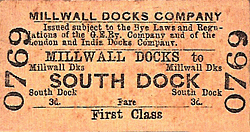 |
The GER built a new pier at North Greenwich and in 1974 ancient rights to carry passengers were transferred to the GER with through tickets to South Greenwich available from Fenchurch Street. This service continued until the London County Council opened a pedestrian subway under the river at Greenwich on 4th August 1902. With the opening of |
this tunnel the GER agreed to withdraw the ferry service from 31st October after receiving £8,000 in compensation.
Through locomotive haulage on the branch finally started on the 23rd August 1880 after bridges had been strengthened and three small 2-4-0 ST locomotives had been acquired. At this time, the working of the branch was taken over by the Millwall Dock Company with a 15-minute service from 7 a.m. In November 1922, the Port of London Authority, as successor to the dock companies after 1909 replaced the existing steam engines which ex-GWR rail motors and to facilitate these, a number of bridges had to be further strengthened.
 |
The line had never proved popular with passengers and had been steadily in decline except when Millwall Rovers Football club were playing at home, on these days the tiny locomotives often pulled five crowded coaches. This seasonal traffic was however lost when the club moved south of the river to New Cross in 1910. During WW1 the service was reduced to two trains an hour and with many of the passengers lost to motor busses closure was inevitable and was announced for 30th June 1926. This was, however, pre-empted on 4th May 1926 when locomotive crews were stopped by pickets during the General Strike and the service was never reinstated. Freight traffic continued over part of the route until 1929 but the line between North Greenwich and Glengall Road was completely closed and part of the viaduct was demolished in c.1936.
In December 1982 Government approval was given for the Docklands Light Railway which would utilise the London & Blackwall line between Minories and Poplar. The DLR opened on 31st August 1987. Initially the DLR consisted of three branches with their termini at Tower Gateway, Stratford and Island Gardens. The Island Gardens branch turned south at Poplar running through the Canary Wharf development joining the old North Greenwich alignment at Crossharbour close to the site of the old Millwall Docks Station from where to DLR followed the course of the Millwall Extension Railway across the Millwall viaduct to Island Gardens which was built roughly on the site of the former North Greenwich terminus.
| Shortly after the DLR opened, Lewisham Council commissioned a feasibility study of extending the DLR under the Thames to Lewisham. The line was eventually authorised, its proposed alignment left the original DLR route south of Crossharbour dropping down to a new a street level station at Mudchute, from where the new line would be built by cut and cover through Millwall |
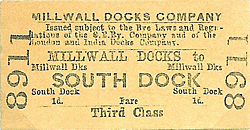 |
Park to a new sub-surface station at Island Gardens, just east of the southern end of the Millwall viaduct. From there the line would tunnel under the Thames and on to Lewisham.
Mudchute and Island Gardens stations closed on 11th January 1999 and the Lewisham extension opened on 20th November 1999, the Millwall viaduct having lost its train service for the second time. It can still be seen today in Millwall Park and is the only tangible evidence of the Millwall Extension Railway.
Sources: The London & Blackwall Railway by Geoffrey Body & Robert. E. Eastleigh. Trans-Rail Publications 1964.
British History Online web site - University of London
Stepney's Own Railway - A history of the London & Blackwall System by J.E.Connor, Connor & Butler 1984 & 1987 ISBN 0 947699 02 3.
London's Local Railways by Alan A Jackson - David & Charles 1978 ISBN0 7153 7479 6
Tickets from Michael Stewart, route map drawn by Alan Young
For other stations on the Millwall Extension Railway click on the station name:
Millwall Junction, Millwall Docks & North Greenwich
|

old1.jpg)

old1.jpg)